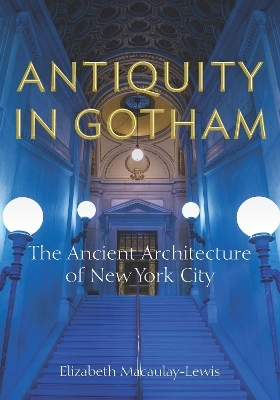
Antiquity in Gotham
Fordham University Press (Verlag)
978-1-5315-0242-3 (ISBN)
Since the city’s inception, New Yorkers have deliberately and purposefully engaged with ancient architecture to design and erect many of its most iconic buildings and monuments, including Grand Central Terminal and the Soldiers’ and Sailors’ Memorial Arch in Brooklyn, as well as forgotten gems such as Snug Harbor on Staten Island and the Gould Memorial Library in the Bronx. Antiquity in Gotham interprets the various ways ancient architecture was re-conceived in New York City from the eighteenth century to the early twenty-first century.
Contextualizing New York’s Neo-Antique architecture within larger American architectural trends, author Elizabeth Macaulay-Lewis applies an archaeological lens to the study of the New York buildings that incorporated these various models in their design, bringing together these diverse sources of inspiration into a single continuum. Antiquity in Gotham explores how ancient architecture communicated the political ideals of the new republic through the adaptation of Greek and Roman architecture, how Egyptian temples conveyed the city’s new technological achievements, and how the ancient Near East served many artistic masters, decorating the interiors of glitzy Gilded Age restaurants and the tops of skyscrapers. Rather than classifying neo-classical (and Greek Revival), Egyptianizing, and architecture inspired by the ancient Near East into distinct categories, Macaulay-Lewis applies the Neo-Antique framework that considers the similarities and differences—intellectually, conceptually, and chronologically—among the reception of these different architectural traditions.
This fundamentally interdisciplinary project draws upon all available evidence and archival materials—such as the letters and memos of architects and their patrons, and the commentary in contemporary newspapers and magazines—to provide a lively multi-dimensional analysis that examines not only the city’s ancient buildings and rooms themselves but also how New Yorkers envisaged them, lived in them, talked about them, and reacted to them. Antiquity offered New Yorkers architecture with flexible aesthetic, functional, cultural, and intellectual resonances—whether it be the democratic ideals of Periclean Athens, the technological might of Pharaonic Egypt, or the majesty of Imperial Rome. The result of these dialogues with ancient architectural forms was the creation of innovative architecture that has defined New York City’s skyline throughout its history.
Elizabeth Macaulay-Lewis is Associate Professor of Liberal Studies and Middle Eastern Studies. She is also the Executive Officer of the MA Program in Liberal Studies at The Graduate Center, The City University of New York.
List of Figures | vii
Introduction: From the Appian Way to Broadway | 1
Why Antiquity?, 2 • Methodologies, Evidence, and Themes:
Archaeology, Reception Studies, and the Neo-Antique,
3 • Organization of the Chapters, 8
1. Herculean Efforts: New York City’s Infrastructure | 13
The Grid, 14 • Rivaling Rome and the Sphinx: The Croton Aqueduct
and Murray Hill Distributing Reservoir, 15 • Bridging the East River
in Style: The Manhattan Bridge, 18 • Train Stations: Appropriating
the Colonnades and Baths of Imperial Rome, 24 • Conclusions, 34
2. The Genius of Architecture: Ancient Muses and Modern Forms | 35
The Parthenon on Wall Street: The US Custom House, 37 • Brooklyn
Borough Hall, the Manhattan Municipal Building, and Foley
Square, 43 • The Tombs, 51 • Conclusions, 55
3. Treasuries of Old and Treasuries of New | 57
Banks, 58 • Warehouses and Commercial Lofts, 63 • The First and
Second Merchants’ Exchanges, 68 • The New York Stock Exchange, 71
• Skyscrapers, 74 • Modernism and Its Debt to Classical Architecture:
The Seagram Building, 82 • Conclusions, 82
4. Modern Museions | 85
The Metropolitan Museum of Art, 87 • The Brooklyn Institute of Arts
and Sciences, 90 • Temples to Monkeys, Birds, and Lions:
The Architecture of the New York Zoological Society, 94 • The
New York State Memorial to Theodore Roosevelt at the American
Museum of Natural History, 96 • Pantheons and a Stadium:
The Architecture of New York’s Universities, 100 • Public
Libraries, 108 • Conclusions, 109
5. Togas at Home | 111
Domestic Architecture and the Greek Revival Style in New York
City, 112 • The Tredwell Home, 114 • Residences in New York
City after the Civil War, 115 • Pompeian Rooms in New York
City, 116 • The Mansion and Greco-Pompeian Music Room
of Henry G. Marquand, 119 • Aspirational Antiquity: Décor and
Design for the Middle Classes, 128 • Apartment Buildings:
Classical Forms in the Sky, 129 • Conclusions, 131
6. Dining Like Nero | 133
The Development of the Lobster Palaces, 133 • Murray’s Roman
Gardens, 136 • The Café de l’Opéra, 150 • Conclusions, 154
7. To Be Buried Like a Pharaoh | 155
New York’s Cemeteries before 1838, 156 • Green-Wood
and Woodlawn, 159 • Classical Temples to New York’s Emperors
and Gods, 161 • Obelisks, Pyramids, Temples, and a
Barque Kiosk, 165 • Conclusions, 172
8. Heroic New Yorkers | 174
Arches to Washington, 177 • The Soldiers’ and Sailors’
Memorial Arch, Grand Army Plaza, 183 • The Column to
Columbus, 192 • Monuments in Early Twentieth-Century
New York, 196 • Conclusions, 198
9. Eclectic Antiquity | 200
Snug Harbor and Grecian Temple Churches, 200 • Bathing
Culture in New York City, 204 • Fraternal Organizations:
The Grand Masonic Lodge and the Pythian Temple, 209 •
Theaters, 211 • Conclusions, 212
Reflections: Useable Pasts and Neo-Antique Futures | 213
Glossary | 219
Acknowledgments | 223
Notes | 227
References | 253
Index | 273
| Erscheinungsdatum | 16.09.2022 |
|---|---|
| Zusatzinfo | 72 color and 43 black and white illustrations. |
| Verlagsort | New York |
| Sprache | englisch |
| Maße | 178 x 254 mm |
| Themenwelt | Kunst / Musik / Theater ► Kunstgeschichte / Kunststile |
| Geisteswissenschaften ► Geschichte ► Regional- / Ländergeschichte | |
| Technik ► Architektur | |
| ISBN-10 | 1-5315-0242-3 / 1531502423 |
| ISBN-13 | 978-1-5315-0242-3 / 9781531502423 |
| Zustand | Neuware |
| Haben Sie eine Frage zum Produkt? |
aus dem Bereich


